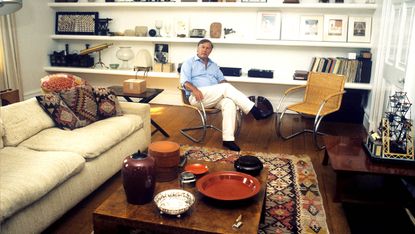Sir Terence Conran’s guide on how to use colour in the home
As you’d expect from the design champion, Sir Terence Conran loves colour at home. Here he tries to wean us off magnolia

In the modern world, we take colour for granted. It is everywhere: in newspapers, on packaging, on computer screens; you can buy coloured fridges, cars, toothbrushes and crockery; you can print out your own colour photos using coloured inks. This was not always the case.
Despite the riot of colour in the natural world, our ability to reproduce what we saw around us in pigments and dyes was strictly limited for a very long time. For centuries, the colours in everyday use came chiefly from plants and earth, which resulted in a soft, muted palette. Brighter colours, such as cochineal, the red dye made from beetles, or pure blue, derived from the rare and costly mineral lapis lazuli, were harder to come by and very expensive. Even a reliable black was hard to achieve.
Technical advances in the 19th century, along with the widening of trade routes, began to increase the range of possibilities for using colour. In the mid-19th century, chemists developed the first synthetic dyes; a few decades later, the development of lithography brought the first colour reproductions of pictures within the reach of the ordinary household.
Subscribe to The Week
Escape your echo chamber. Get the facts behind the news, plus analysis from multiple perspectives.

Sign up for The Week's Free Newsletters
From our morning news briefing to a weekly Good News Newsletter, get the best of The Week delivered directly to your inbox.
From our morning news briefing to a weekly Good News Newsletter, get the best of The Week delivered directly to your inbox.
It was only in the second half of the 20th century, however, that colour really exploded into everyday life. Today’s world of cheap and cheerful colour comes from the growth of the synthetics industry in the post-war period, which ensured that colour would never be available only to the wealthy again. Ever since the arrival of the first newspaper colour supplement and the first colour TVs, colour has been embedded in mass consumer culture.
Despite this saturation – or perhaps because of it – the pigment manufactured in the largest quantities today remains white. Many people are hesitant about using colour in their homes, with safe, neutral tones, whites and off-whites all too often the norm. Rather than being spoilt for choice, when it comes to being imaginative with colour, we are often daunted by it.
There is nothing wrong with neutral or natural schemes, and a predominance of white as a background in many of today’s interiors reflects an understandable desire to enhance space and light, two elements we prize in contemporary décor.
However, there is also a misconception that colourful surroundings are tiring to live in, as well as a fear of ‘getting it wrong’. It is true that working with colour takes a degree of skill, and that trial and error may come into it. There are, though, ways of introducing colour to the home that can help build up confidence and expertise in colour-handling without running the risk of making an expensive mistake.
To turn your back on colour altogether is to miss the opportunity to explore its unique ability to evoke atmosphere and feeling; to lift our spirits and express joie de vivre. Colour is the spice of life. Add it to the recipe.
Sir Terence Conran’s guide to colour in the home
Red
The colour of strong feeling (love, anger) or alert (poisonous berries, stop signs), red speeds things up. In the wrong circumstances it can also over-stimulate. On the other hand, traditionally, red fabrics were chosen for galleries in grand houses. It adds welcome warmth, particularly if the quality of natural light is chilly or poor.
Pink
Delicate, flattering and luxurious in the right context, pink can also appear insipid or cloying if not carefully used. An earthy pink, the colour of unfinished plaster, is a relaxing and comfortable background colour.
Orange
From gentle peach or apricot tones to strong shades bursting with the warmth of the sun, orange fosters a sense of well-being. It is also associated with modernity – it first became popular in Art Nouveau and Art Deco decorative schemes, then saw a revival in the pop-inspired 1960s and 70s. An energising, eye-catching shade, it is said to be the first colour that babies can recognise. Earthier burnt orange tones create hospitable, soothing backdrops redolent of warmer climates.
Yellow
In decoration, bright, pure yellow was unknown before the invention of chrome yellow at the beginning of the 19th century; previously yellow had been produced using the earth pigment ochre. From pale buttermilk, through sharp citrus, to rich, warm golden shades, yellow naturally brightens any room. In a kitchen, it can promote a feeling of hospitality, but it can also create a more stately mood in living areas. Yellow, though, can be difficult to get right. The proper shade will depend on existing conditions of natural light.
Green
Occupying the middle of the spectrum, green is the most restful colour of all because our eyes have to make the least adjustment to see it. Green fabric blinds and lampshades are traditional means of screening strong light. Green is associated with fertility, growth and nature (the names we have for its shades tend to be mint, olive etc). But it has negative connotations too (illness, jealousy), and the greenish cast of fluorescent light is very unflattering.
Blue
There is an incredible variety of blues, from pale powder blue to deep intense indigo, from edgy lavender and blue-grey to turquoise and blue-green. Depending on the particular shade, it can be elegant and fresh, or cheery and domestic. An essentially contemplative colour, blue can be used in large doses without appearing too dominant.
Violet
At the extreme end of the spectrum, blue bleeds into violet. Pale shades of violet can be very sophisticated and refined. Harder to handle is purple, with its strong overtones of secular and religious authority.
White
For many centuries, white, from lime-based distemper, was strictly a utility colour for workrooms. With the arrival of electricity and, in the 1930s, the new brilliant titanium white paint, all-white schemes became the height of Modernist fashion. Conversely, for years, the, warmish off-white magnolia has been a fail-safe choice for those uncertain about colour. Choosing the right white means thinking about natural light: sunny rooms can take cooler whites; warmer or creamier whites work better in areas where natural light is poor. Many manufacturers add a touch of blue to their white paints to give added ‘brilliance’, but the result can be a bit glaring.
Grey
Although it sounds dreary, grey can be both a great mediator and a subtle, refined background in its own right. Grey ranges from the palest whisper of smoke to a deep battleship shade that packs graphic punch. Livery blue-greys are cool, refined; warmer mushroom tones are compatible with earthy colour schemes.
Terence Conran Essential Colour is published by Conran Octopus, £12.99; octopusbooks.co.uk
Sir Terence Conran is one of the world’s leading designers, furniture-makers, restaurateurs and retailers. His books include The Essential House Book, Conran on Design, Design: Intelligence Made Visible, Outdoors, Inspiration, and the Eco House Book.
Create an account with the same email registered to your subscription to unlock access.
Sign up for Today's Best Articles in your inbox
A free daily email with the biggest news stories of the day – and the best features from TheWeek.com
-
 'Consumers fed up with food costs ditch big brands'
'Consumers fed up with food costs ditch big brands'Today's Newspapers A roundup of the headlines from the US front pages
By The Week Staff Published
-
 What would it be like in jail for Trump if he's convicted?
What would it be like in jail for Trump if he's convicted?Today's Big Question The Secret Service has begun grappling with how to protect a former president behind bars
By Rafi Schwartz, The Week US Published
-
 How much can you save shopping secondhand?
How much can you save shopping secondhand?The Explainer Many Americans are buying pre-owned items to counteract the effects of inflation
By Becca Stanek, The Week US Published